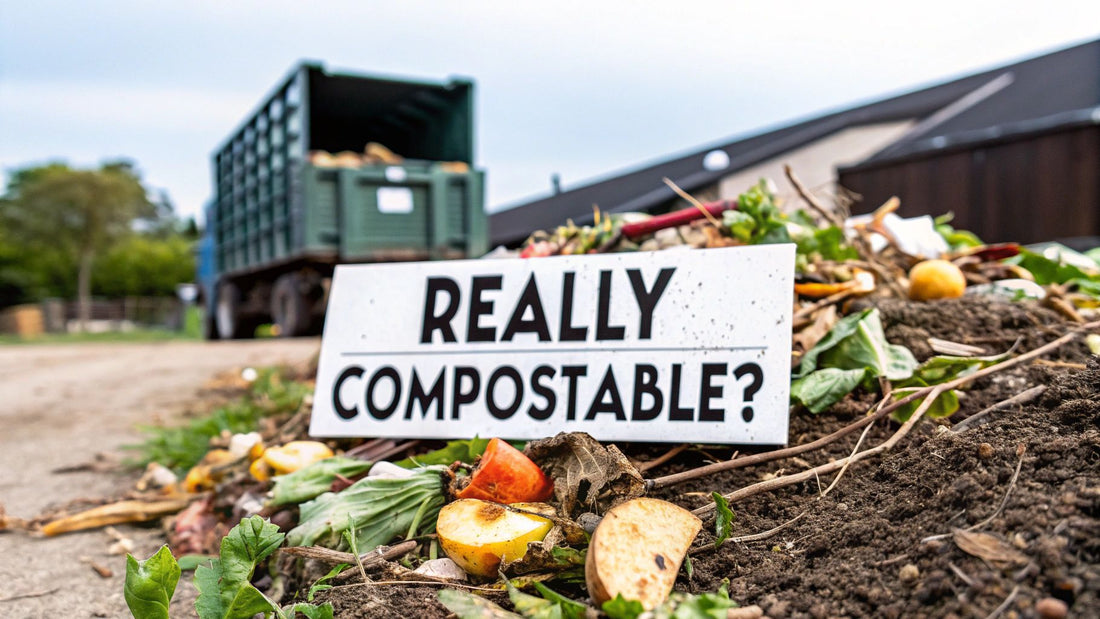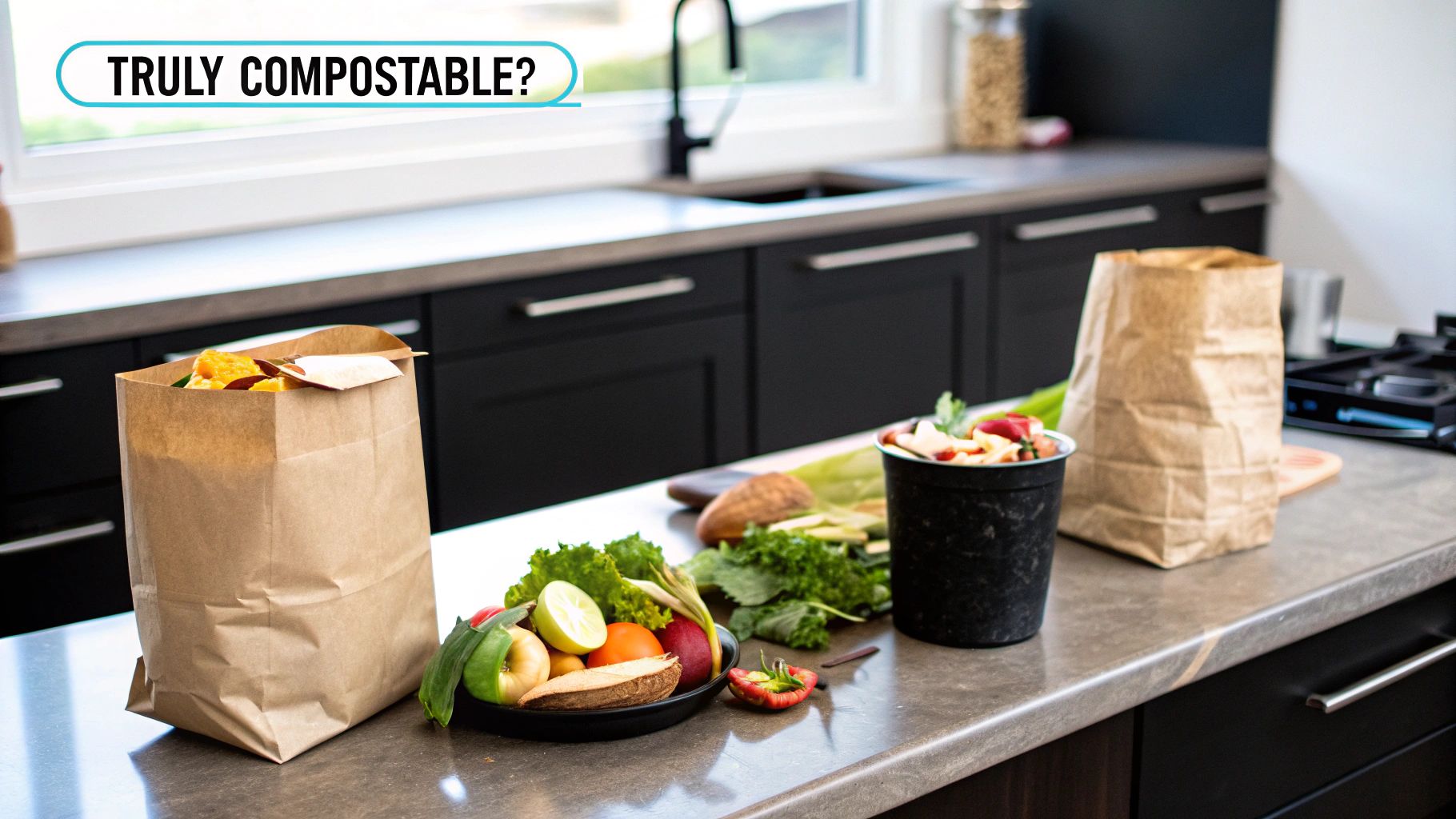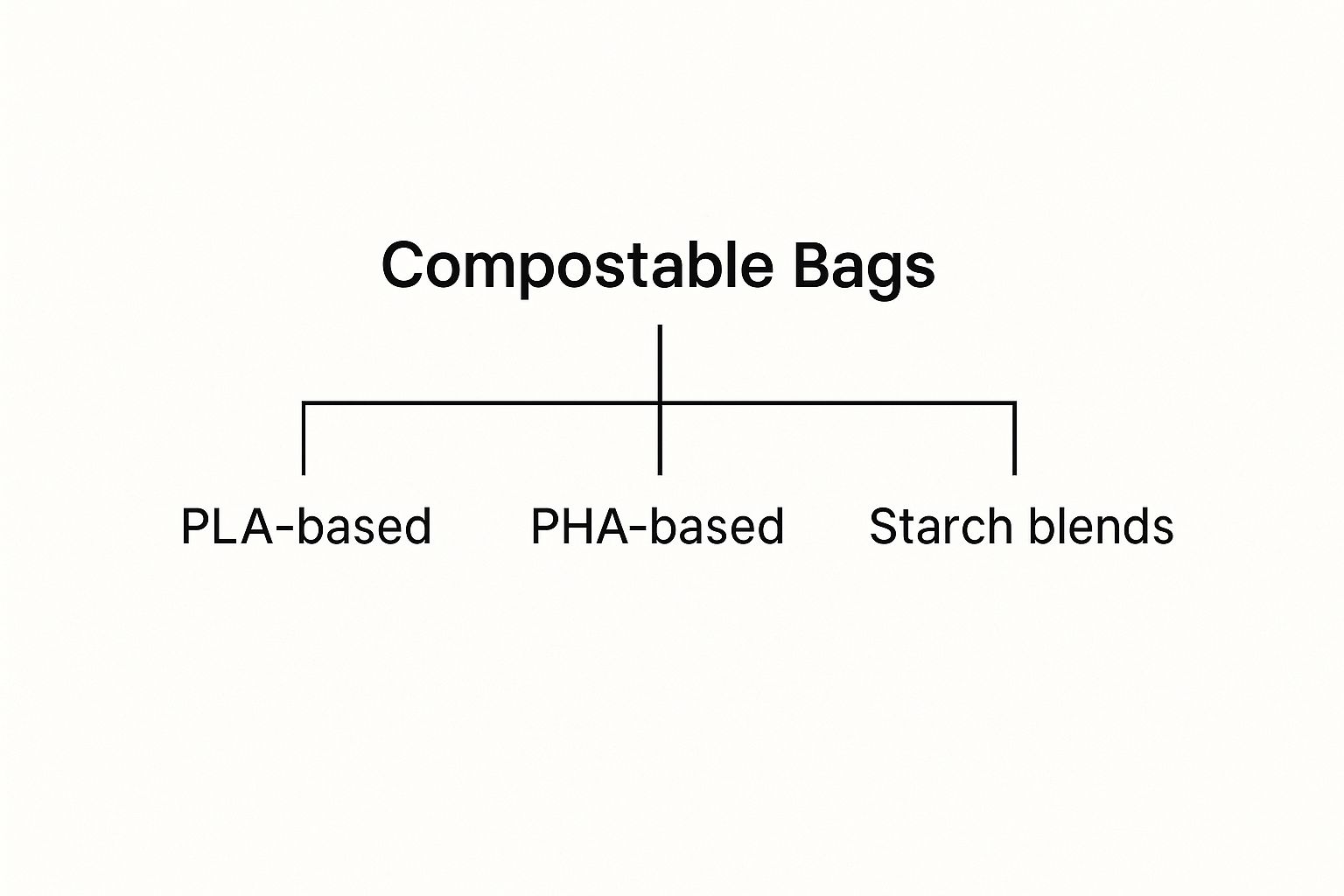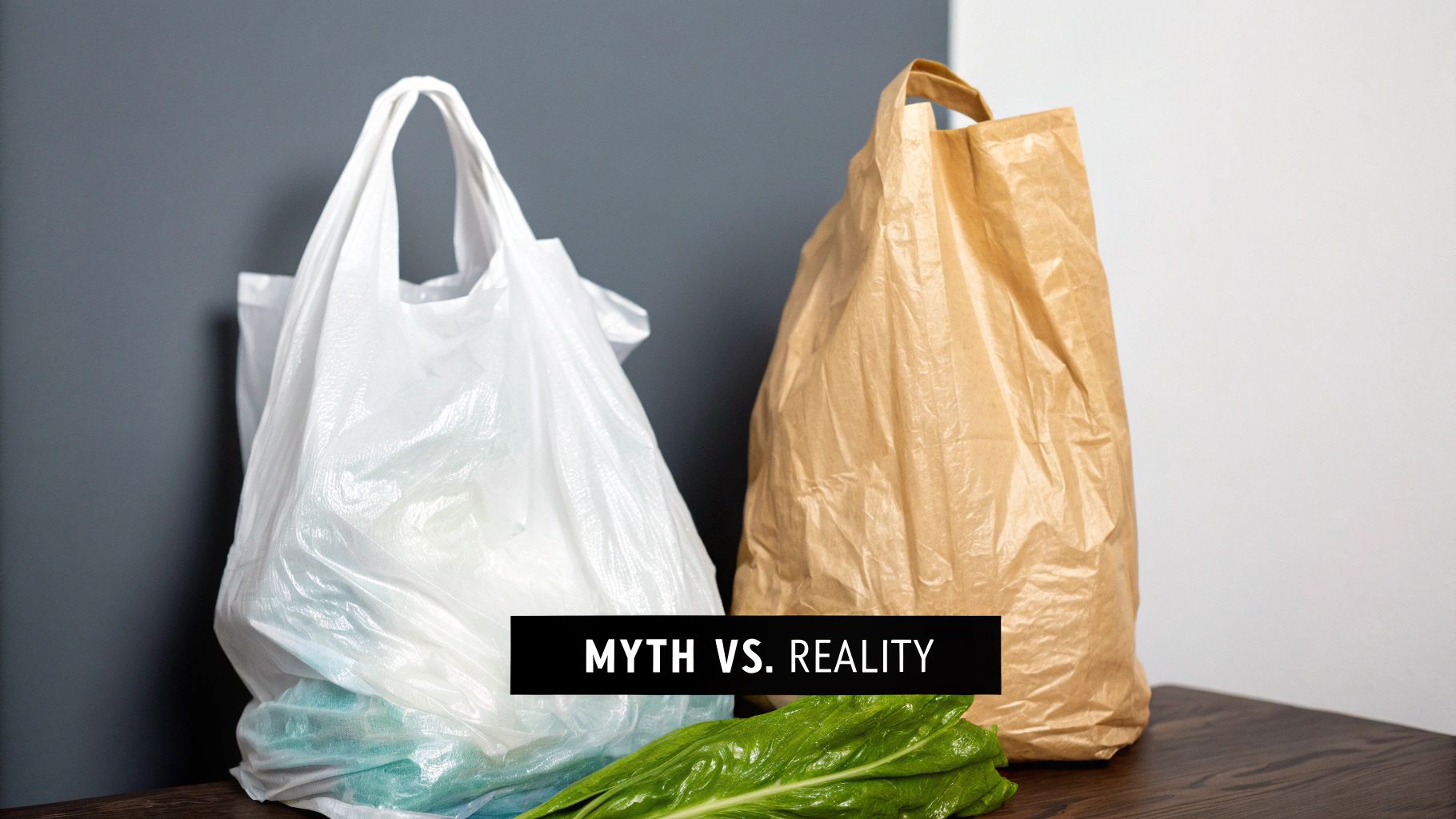
Are Compostable Bags Really Compostable?
Share
Let's cut to the chase: are those "green" compostable bags you're buying really compostable? The answer is a resounding yes—but only if they end up in the right place. And that's a condition so critical, it changes everything.
For a compostable bag to fulfill its environmental promise, the conditions aren't just a suggestion; they are an absolute requirement. Miss that step, and your good intentions could backfire, creating more harm than good.
The Uncomfortable Truth About "Compostable" Bags
You've seen them everywhere, promising a guilt-free solution to our plastic problem. But as you fill one with coffee grounds and vegetable peels, a healthy skepticism is warranted. Is this bag truly better for the planet, or is it just clever marketing?
The truth is, "compostable" is a highly specific technical term, not a vague promise.
A certified compostable bag is like a precision-cut key designed for a single, high-tech lock: an industrial composting facility. In that specific environment, the key works flawlessly. The bag breaks down into water, carbon dioxide, and nutrient-rich compost, returning to the earth just as intended.
But try that same key on any other lock—like your backyard compost pile or, far worse, a landfill—and it will fail completely. The bag will remain, its purpose unfulfilled, its potential locked away.

Why The Right Environment Is Non-Negotiable
A compostable bag's entire value hinges on its final destination. An industrial composting facility is an engineered biological powerhouse. It’s a controlled environment with intense heat (often 130-160°F), managed moisture, and a constant supply of oxygen to fuel the microorganisms that rapidly break down organic material.
The vast majority of compostable bags, especially those made from bioplastics like PLA (polylactic acid), are scientifically engineered to decompose only in these demanding systems.
Take away those conditions, and the bag's eco-friendly promise vanishes. In a landfill, starved of oxygen, a compostable bag becomes a liability. It will either sit intact for decades or, more troublingly, release methane—a greenhouse gas far more potent than carbon dioxide.
And your home compost pile? It simply can't generate the sustained, intense heat required. Instead of becoming rich soil, the bag will likely persist as a stubborn, plastic-like sheet for months, or even years.
To understand the stakes, you need to see the real-world outcomes.
The question you must ask isn't whether the bag can compost, but whether it will compost in the disposal system you actually have access to.
Compostable Bag Reality Check
This table reveals what truly happens to a "compostable" bag in different scenarios. It's a blunt assessment that cuts through the greenwashing.
| Disposal Method | What Happens to a Compostable Bag | Is It Truly Compostable Here? |
|---|---|---|
| Industrial Composting Facility | The bag completely breaks down into soil, water, and CO2 within a set timeframe (90-180 days). | Yes. This is the only environment where it works as designed. |
| Home Compost Pile | It will persist for an extremely long time, failing to decompose because temperatures are far too low. | No, unless it carries a specific "Home Compostable" certification. |
| Landfill | Buried without oxygen, it cannot compost. It becomes a source of potent methane emissions. | No. It actively contributes to climate change. |
| Recycling Bin | It contaminates the plastic recycling stream, forcing entire batches to be landfilled. | No. It is a contaminant that undermines recycling efforts. |
As the evidence shows, a compostable bag’s destiny is sealed by where it goes. Without access to the right facility, its environmental benefits are not just lost—they are reversed.
So, What Does 'Compostable' Actually Mean?
To definitively answer, "are compostable bags really compostable?" you must understand that "compostable" is a scientific standard, not a marketing buzzword. It's a promise backed by rigorous testing. For a bag to earn that title, it has to meet strict, non-negotiable criteria.
True compostability demands that a material breaks down completely into natural, non-toxic elements: water, carbon dioxide, and organic biomass. Critically, this must happen within a defined timeframe, typically 90 to 180 days, and only under the managed conditions of a commercial composting facility.
Compostable vs. Biodegradable vs. Degradable: The Critical Difference
These terms are often used interchangeably, but they represent vastly different outcomes. Mistaking one for another can lead you to make poor environmental choices.
- Compostable: This is the gold standard. Think of an apple core in a hot compost bin—it vanishes, becoming nutrient-rich soil without leaving any toxic residue behind. This is a verified, beneficial outcome.
- Biodegradable: This term is dangerously vague. A fallen log is biodegradable, but it can take decades to disappear. The term carries no guarantee about timeframe or toxicity, making it almost meaningless on consumer products.
- Degradable: This is often the most deceptive. These are typically conventional plastics with chemical additives that cause them to shatter into microscopic, invisible pieces called microplastics, which persist in the environment forever.
Let this sink in: all compostable items are biodegradable, but the vast majority of biodegradable items are not compostable. The "compostable" label is a legally-defined promise of a specific, beneficial outcome.
The Science Behind How Compostable Bags Work
What is the secret that allows a bag to be truly compostable? It’s the raw materials. Unlike petroleum-based plastics, compostable bags are made from plant-based materials like corn starch or PLA (polylactic acid). You can explore this further in our guide on what compostable bags are made of.
These biopolymers are designed to be a food source for the microorganisms found in industrial compost piles. When provided with the intense heat, moisture, and oxygen of that environment, these microbes rapidly consume the bag, returning it to simple organic matter.
This science is driving a massive market shift. The demand for compostable packaging, valued at USD 112.49 billion in 2025, is projected to soar to USD 232.47 billion by 2034. This explosive growth proves a global commitment to creating a circular economy where our waste becomes a resource.
Ultimately, the science is clear. A bag is only truly compostable if it's made from the right materials and disposed of in the one environment capable of completing its lifecycle.
How to Read Compostable Certifications
When you see a bag labeled "compostable," your first reaction should be skepticism. Is that claim legitimate or just wishful marketing? Without an official certification logo from a trusted third party, that claim is nothing more than words on a package.
These certifications are your only proof. They are the equivalent of an "organic" seal on food—a guarantee that the product has been independently verified to meet strict standards. Learning to identify these logos is what separates a hopeful consumer from an empowered one who can distinguish a true solution from a greenwashed fake.
These certified bags are typically made from bioplastics like PLA, PHA, and starches, all engineered to break down under very specific conditions.

Decoding Compostable Bag Certifications
To know with certainty what you're buying, you must be able to recognize the logos of these third-party verifiers. This table shows the world's leading certifications and what they actually guarantee.
| Certification Logo | Governing Standard | What It Means | Where It's Used |
|---|---|---|---|
 |
ASTM D6400 | The product is certified to decompose safely in a commercial composting facility. | Primarily North America (USA & Canada) |
 |
EN 13432 | The European equivalent, confirming the product is suitable for industrial composting. | Europe and recognized globally |
 |
OK compost HOME | The gold standard for backyard composting. Guarantees the product will break down at lower temperatures in a home compost pile. | Europe and recognized globally |
These certifications are not just for aesthetics. They are proof of rigorous scientific testing for three critical factors: complete disintegration (breaking into non-visible pieces), biodegradation (being fully consumed by microbes), and non-toxicity (ensuring the final compost is safe for soil and plants). Without this verification, you have absolutely no guarantee the bag will perform as advertised.
Industrial vs. Home Compostable: A Critical Distinction
Here is where most well-intentioned consumers make a crucial error. The overwhelming majority of compostable bags are certified for industrial composting only. This means they require the intense heat and controlled conditions of a large-scale facility to break down.
A bag certified for industrial use will unequivocally fail in a backyard pile. It will sit there for months, even years, a stubborn sheet of plastic-like material, because home compost simply cannot generate the necessary heat.
If you are a home composter, you must seek out a separate, specific certification: "OK compost HOME" from TÜV AUSTRIA. This is your only assurance that a bag is designed to decompose in the cooler, more variable environment of a backyard bin.
The market for these products is expanding rapidly, with a current value of around USD 4 billion and a projected growth of 15% over the next five years, driven by consumer demand and anti-plastic legislation.
Choosing the right bag is paramount. Our guide to the best compostable trash bags can help you find certified products. But always start by checking the packaging for these logos to ensure the bag you choose aligns with the composting system you actually use.
Industrial Composting Versus Your Backyard Pile
Have you ever tossed a "compostable" bag into your garden compost, only to find it months later, looking mockingly intact? This experience is the root of most doubts about compostable products. It also proves the single most important fact about them: they are designed for highly specific environments.
The definitive answer to "are these bags really compostable?" is: only in the right one. The vast majority of bags sold today are engineered exclusively for industrial composting facilities—environments that bear no resemblance to your backyard setup. The difference is not one of degree, but of kind.

Industrial Facilities: The High-Tech Pressure Cooker
An industrial composting facility is a biological pressure cooker, a high-tech system designed to decompose tough organic materials with maximum speed and efficiency.
Here’s what makes these facilities the only place for most compostable bags:
- Intense, Sustained Heat: These operations are scientifically managed to reach and maintain temperatures of 130°F to 160°F (55-71°C). This extreme heat is non-negotiable for breaking down the tough molecular bonds in bioplastics like PLA.
- Constant Oxygen Flow: Massive machinery turns and aerates the piles, supplying the oxygen-loving microbes with everything they need to work at peak efficiency.
- Managed Moisture Levels: Moisture is precisely controlled to create a hot, steamy, tropical environment where decomposition happens at an accelerated rate.
- The Right Microbial Blend: These facilities are essentially microbe farms, cultivating diverse communities of microorganisms that specialize in devouring complex organic matter, including certified compostable bags.
An industrial composting facility is not a passive pile of waste; it is a finely tuned biological engine. It creates the high-energy conditions that most compostable bags are specifically engineered to require.
Without this "pressure cooker" environment, a standard compostable bag simply cannot break down as intended. The bioplastic it's made from requires that intense heat to trigger the decomposition process. This leads us to the very different world of your backyard pile.
Your Backyard Pile: The Humble Slow Cooker
If an industrial facility is a pressure cooker, your home compost is a slow cooker. It is a wonderful, passive process for turning kitchen scraps and yard trimmings into garden gold, but it operates on a completely different level of power and intensity.
The conditions in a home compost pile are far less predictable and significantly less powerful.
- Lower Temperatures: A backyard pile rarely reaches temperatures hot enough, for long enough, to break down bioplastics. It might briefly hit 100-120°F, but it lacks the sustained, blistering heat of an industrial operation.
- Passive Aeration: Oxygen supply depends entirely on manual turning with a pitchfork. It's a slow, inconsistent process compared to the active aeration at a commercial site.
- Unpredictable Moisture: Your pile is subject to the whims of weather, getting too dry in a heatwave or too waterlogged in a storm, either of which can halt decomposition.
This "slow cooker" method is perfect for fruit peels and coffee grounds, but it simply lacks the thermal and biological horsepower to break down the resilient polymers in most compostable bags. The bag isn't failing; it was simply put in the wrong appliance.
This distinction is everything. It means that unless you have access to a curbside composting program that accepts these bags, they are not the eco-friendly solution you believe them to be. Their promise is inextricably linked to the industrial infrastructure built to process them.
So, Why Do Most "Compostable" Bags End Up in the Trash?
Here we arrive at the inconvenient truth. You've done your part: you researched and bought certified compostable bags, filling them with your organic waste. But now, you face a systemic failure.
Despite our best intentions, the overwhelming majority of compostable bags in the United States never reach a composting facility. They are hauled to the one place they were designed to avoid: the landfill. This is not a failure of the product, but a colossal failure of our national waste infrastructure.
The Great Composting Divide
The single greatest barrier to compostable products succeeding is a shocking lack of access to industrial composting facilities. Most bags are engineered for these high-heat environments, yet very few Americans can actually get their waste to one.
Imagine a conscientious person—let's call her Sarah—who wants to do the right thing.
- She buys BPI-certified compostable bags.
- She diligently separates her food scraps: coffee grounds, eggshells, veggie peels.
- When the bag is full, she's ready to dispose of it responsibly.
This is the moment her good intentions collide with a harsh reality. Her city has no curbside organics program. The nearest industrial composter is an hour away and closed to the public. Her only option? With a heavy sigh, she tosses the compostable bag into the regular trash, condemning it to the landfill.
Sarah's story is the rule, not the exception. The infrastructure to support the very products being marketed as a solution simply does not exist for most people. The "compost" pathway is a dead end.
The Landfill Problem: A Methane Nightmare
When a compostable bag is sent to a landfill, it doesn't just fail its mission—it becomes an active environmental threat. Landfills are anaerobic environments, meaning they are starved of oxygen. This is the precise opposite of the oxygen-rich conditions required for composting.
Buried under tons of trash, the bag cannot properly decompose. Instead, it breaks down anaerobically, a process that releases methane—a greenhouse gas over 25 times more potent than carbon dioxide at trapping heat in the atmosphere.
In a landfill, a product designed as an environmental solution becomes a source of potent greenhouse gas emissions. In this scenario, it is arguably more harmful than a traditional plastic bag.
This grim reality turns the promise of compostability on its head. Without the correct disposal infrastructure, we are paying a premium for a product that ends up accelerating climate change. To better understand how to manage organic waste, read our guide on using compostable bags for food waste.
The market for these bags continues to expand, driven by eco-conscious consumers. But this growth only illuminates the core problem: without a massive, nationwide investment in composting infrastructure, these bags cannot fulfill their purpose and risk making pollution worse. You can get more insights into this market and its challenges by reading the full research from 360iResearch.
How to Use Compostable Bags the Right Way

It's clear the system is broken, but your individual choices can still drive meaningful change. We've seen how easily good intentions can backfire, so let's establish a clear, responsible plan of action that works in the real world. To finally answer, "are compostable bags really compostable?" you must follow a deliberate process.
You must become a discerning investigator, not just a passive consumer. The right choice isn't about buying a "green" product; it's about matching that product to your real-world disposal options. This simple checklist will force you to make a decision that genuinely helps the planet.
A Practical Checklist for Responsible Use
Follow these steps in this exact order. This process ensures you don't inadvertently contribute to the very problem you're trying to solve.
Step 1: Demand Real Certification
Never accept a "compostable" claim at face value. Before you buy, flip the package over and find a third-party certification logo. You are looking for seals from BPI (which verifies the ASTM D6400 standard) or TÜV AUSTRIA (for the EN 13432 standard). Without one of these seals, the bag is not a legitimate compostable product.
Step 2: Confirm a Viable Destination
This is the most critical step. A certified bag is worthless if it has nowhere to be composted. First, investigate if your municipality offers a curbside organics collection program. If it does, your work isn't done. You must call or check their website to confirm they explicitly accept compostable bags. Some facilities do not, and you cannot risk contaminating their system.
A compostable bag's value is 100% dependent on the infrastructure available to process it. If there is no pathway to a commercial composter, its environmental benefits are zero.
Step 3: Verify Home Compostability (For Backyard Composters Only)
If your only option is a backyard compost pile, you must be even more selective. Standard BPI-certified bags will not break down in your bin. You must find bags that carry a specific "Home Compostable" certification, such as the "OK compost HOME" seal. These are the only products engineered for the lower temperatures of a home system.
What to Do If You Have No Composting Access
If you've gone through the checklist and have no viable composting option, the conclusion is unavoidable: a compostable bag is not the right choice for you. In this situation, buying one is likely worse for the environment than the alternatives.
Here are smarter actions you can take:
- For Kitchen Scraps: Go liner-free with a countertop pail and simply rinse it after emptying. Alternatively, use certified compostable paper bags or wrap food scraps in old newspaper, both of which break down far more easily.
- For General Waste: The most powerful action is to reduce waste at its source. Reusable containers and bags for shopping and storage must be your default choice.
By following this rigorous process, you can make a choice grounded in reality, not marketing. This is how you ensure your actions support a healthier planet.
Your Questions About Compostable Bags Answered
https://www.youtube.com/embed/egyNJ7xPyoQ
We've covered the hard truths, but some questions may remain. Let's tackle the most common ones head-on to ensure you can act with total confidence.
Can I Put Compostable Bags in My Recycling Bin?
No. Under no circumstances should a compostable bag ever be placed in a recycling bin. This is a critical rule.
Recycling facilities are designed to process conventional plastics like PET and HDPE. Compostable bioplastics are considered a contaminant. When a compostable bag enters the recycling stream, it can ruin an entire bale of recyclable material, forcing it all to be sent to a landfill. It actively harms recycling efforts.
What Happens If a Compostable Bag Ends Up in the Ocean?
A compostable bag is not designed to break down in marine environments. The cold, dark, and oxygen-deprived conditions of the ocean are the polar opposite of a hot, aerated compost pile.
The bag will not harmlessly disappear. It will persist for a very long time, eventually fragmenting into microplastics that pose the same deadly threat to marine life as any conventional plastic bag.
The idea that "compostable" means "disappears in any natural setting" is a dangerous myth. These bags provide an environmental benefit only when disposed of in a proper composting facility.
Are There Better Alternatives to Compostable Bags?
Yes. The best choice depends on the application, but the ultimate goal is always to reduce single-use consumption.
- For Shopping: A reusable cloth or mesh bag is unquestionably superior. They are durable, washable, and eliminate waste entirely.
- For Kitchen Scraps: Going liner-free with a small bin that you rinse regularly is a zero-waste option. Another excellent choice is a certified compostable paper bag, which decomposes easily in any compost environment.
If I Can’t Compost It, Which Bag Is Better to Use?
This is a tough but crucial question. If sent to a landfill, a compostable bag can release methane, a greenhouse gas far more potent than CO2. A traditional plastic bag, while persisting for centuries, is largely inert in a modern, lined landfill.
The only responsible approach is to match your bag to your available waste system. If you have verified access to an industrial composting facility that accepts them, a certified compostable bag is the clear winner. If you do not, its environmental benefit is negated, and your focus must shift to reusable options as the most impactful choice you can make.
At terravera, we champion honest, effective solutions for a healthier planet. Our certified compostable bags are engineered to perform exactly as promised—in the right systems—to help you close the loop on organic waste responsibly. Discover the terravera difference today.
